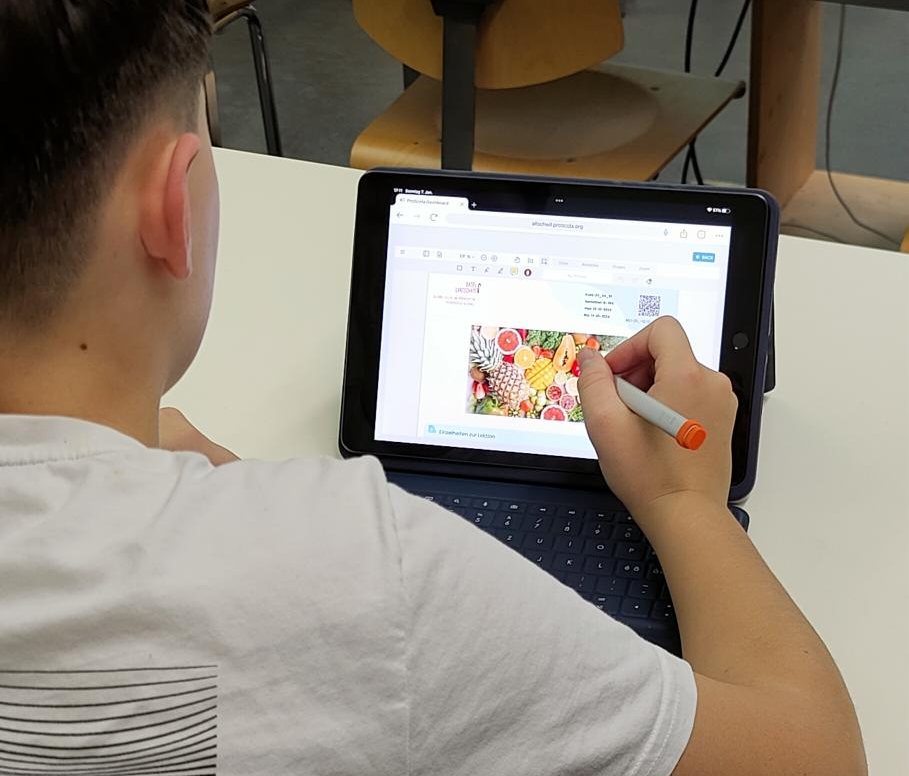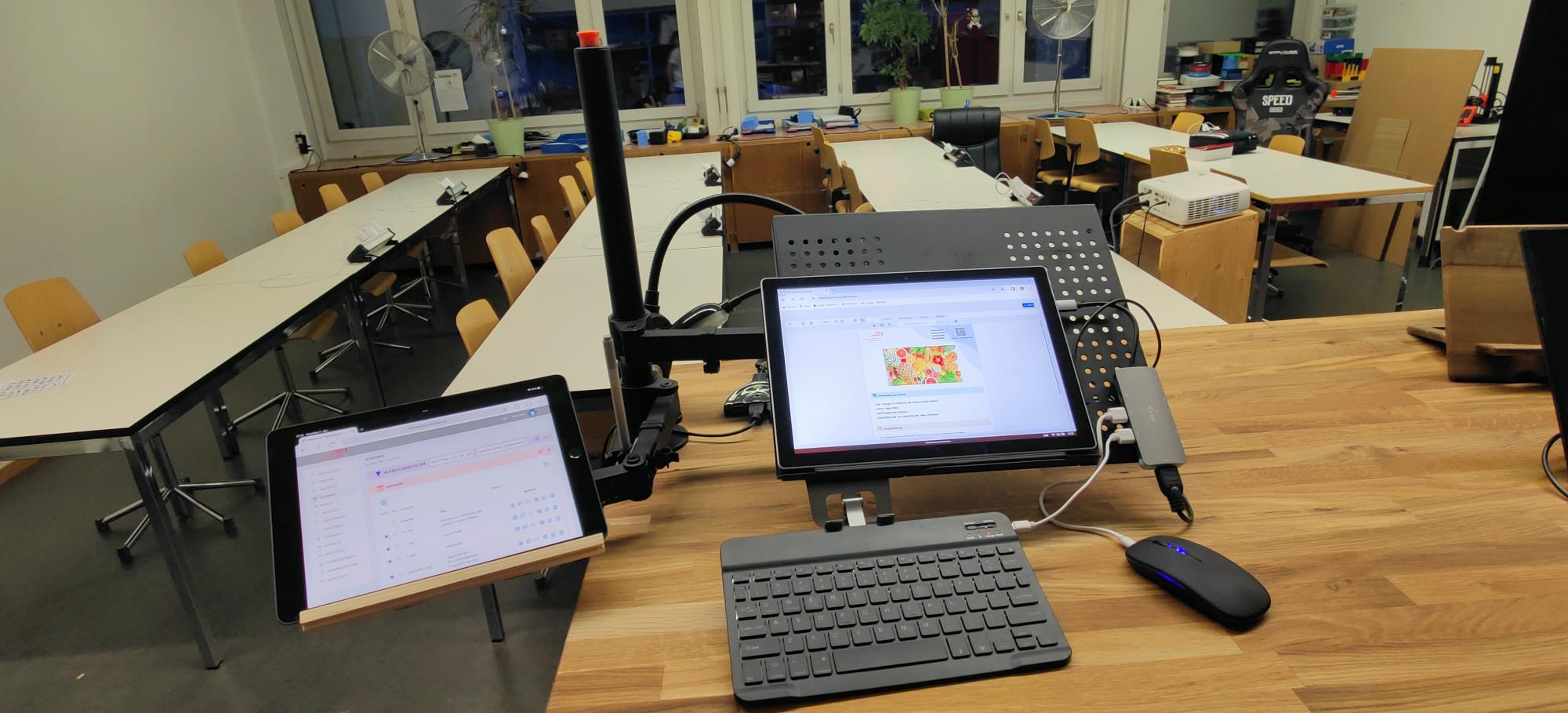Taking the Plunge
At the beginning of the 22/23 school year, I decided to take the plunge and completely digitize my entire teaching process, including preparation and post-processing. This would mean eliminating teaching materials on paper, paper reference materials and even my notebooks. I would need to rely solely on my digital devices. More importantly, so would my students!
Preparing for Change
To ensure I wouldn't back out of the decision, I removed all printed teaching materials from the classroom well before the start of the school year, keeping only drawing paper. I also ensured that every desk in the classroom had its own power outlet so that the students could keep their devices charged. I changed my position in the classroom, moving from the traditional front of class position to the side. This enabled me to see the students whilst simultaneously viewing the projected image from the projector.
Questions and Concerns
To say that I had no concerns would be untrue. My biggest concern was whether I would be making more work for myself - spending more time dealing with technology issues than actually teaching! Since I have a class with students who have various learning challenges, I wasn't sure if this transition would be well-received. Would they get distracted by the technology? Would I overwhelm them? Did it make pedagogical sense, and what would I gain from it?
A Little Solace
I found solace in the fact that I wasn't technologically inept, and I had two years’ experience with the ProScola app (I am a co-founder of ProScola as well as a teacher). Previously, I had only used the app as a digital archive for my lessons and learning materials because it allowed me to easily copy previous lesson preparations to use in future years. This saved me a lot of time, but I knew ProScola could provide more assistance as I moved to full digital teaching.
I had printed my lessons on paper for the students and taught and worked with them in a traditional analogue fashion. The next logical step was to teach with these digital materials and after that, have the students work directly on tablets with the materials I had created. This is a significant advantage of ProScola, as it allows you to transition to digital, in easy steps.
Engaging the Students
In August 2022, I started implementing these changes and presented my students with a fait accompli. I told them that from now on they would only need a pencil case with pens as a backup and their iPads. The students were excited about not having to carry notebooks and books anymore, but they were even more thrilled when I told them that we would likely have the most modern classroom in Basel Land if not in all of Switzerland!

In the first lesson in this new mode, I showed them how to edit the lessons I had created using their fingers or touch pens. They could write text, draw geometric figures, add comments, and insert images into the documents. Initially the students were concerned that they didn't know how to save their work and they were surprised to learn that they didn't need to save their work in ProScola. In the last part of the lesson, I helped the students familiarize themselves with the ProScola app and understand the difference between a lesson and a task. This was straightforward because the app's timeline allowed structured and logical access to all functions.
Leaving the Chalk Behind
One of the biggest changes in moving to digital teaching and live annotation is leaving the blackboard behind and learning how to use individual annotation tools. This took a little time, but it was worthwhile as I no longer needed to use a sponge to erase the blackboard, and I didn't have to erase anything to make room for new content. Using the digital tools in ProScola, I could do things that were previously impossible.
One very simple but important example of this is using a virtual pointer or marker to highlight where we are in a text while reading. Every teacher knows this from their daily work. A student hasn't been paying attention but needs to continue reading, so you have to remind them of the line number or location where you are in the text. This may sound trivial, but it can be quite annoying over time.
This is just one example of the new methods that naturally emerge in the app, and there are many of them. It is extremely satisfying to learn these, and I have found they emerge very naturally over time. I found I was able to guide the students digitally in the classroom, with them being taught on their tablets and taking notes directly on them.
A Positive Impact
Over time, I introduced more tasks for each lesson. Tasks in ProScola refer to assignments, exercises, homework, portfolios, and tests. I can now conduct all these elements of teaching digitally. This area has had the greatest positive impact on me, in terms of time saving. This is due to the implementation in the ProScola app: where each task physically exists as a single file but with separate layers for the teacher and student. The task is displayed to the students in the correct context of the lesson and the schedule on the timeline. Each student can work on this task, but only on an individual, personal layer. The original remains untouched.
There are other layers in ProScola as well: a ‘solution’ layer, where I can describe the correct solutions to the students when needed and at the right time; a ‘teach’ layer for lesson markup, which students do not have access to; and a ‘correction’ layer above the students' individual personal layer, where I can individually correct each student. All of this is complemented by administrative functions that allow me to control, track, and monitor the students' work.
The Benefits of Digitization
What benefits has the transition to digital brought me? Firstly, I no longer have to deal with forgotten learning materials from students, no more copying, replacing materials, asking students, or disciplinary escalations due to organizational processes.
This was a relief, especially in my special education class, because these students often struggle the most with organization. I also noticed that overall, I have less difficulty motivating and engaging students in the classroom. They are less distracted and complete their tasks more thoroughly than before.

I am also able to correct and monitor a much larger volume of assignments and homework from the students. How many of us teachers correct more than just a random sampling of student homework and assignments in a superficial manner? In ProScola, this is possible with the solution layer, where I can provide generally valid solutions and corrections that I only need to create once, rather than writing them out for each individual student. Individual corrections are minimized, and they are also more comprehensive because I can now provide feedback and corrections orally via audio comments directly in the task itself.
My Personal Highlight - Digital Tests
Beyond all these benefits, my personal highlight is conducting digital tests, where I can work much more extensively with text, graphics, audio, and images than I could in a traditional manner.
I start by creating a test, for example, in Word, then create a task of the "Test" category and set a schedule for it. Students can only access the content within this time frame, although they can see the test's scheduling beforehand, which supports the students' self-organization. After creating the test, I immediately create a solution layer with the correct answers.
Next, I have the test administered. Through ProScola, I can directly view each student's ongoing test. I can see immediately when a student submits their test. When a student submits their test, I can correct it immediately on the individual correction layer, and all students can access the solution layer immediately after submitting the test to see what they got right and wrong.
Students typically bombard the teacher with questions after each test, wanting to know if what they wrote is correct. Thanks to the ability to correct live, I often finished correcting the test by the time the test itself ended! At the beginning, it was amusing for both the students and myself because we would think after each test, "Wait, is that it? Something's missing! Did I forget something? This can't be it!"
Conclusion – A Successful Transition, with Help from ProScola!
In hindsight, taking the plunge into the unknown turned out not to be a risk at all. I believe this is because ProScola, compared to other digital tools in education, is a comprehensive, integrated tool that aligns very well with teaching workflows. As a co-founder of ProScola, it would be surprising if I wasn’t positive about my experience, but our goal as a company was to make making teaching easier – and as much as I want my colleagues to benefit, I wanted to improve teaching for myself! One of the biggest concerns with the transition to digital is the integration of separate tools. I don't have to concern myself with integrating separate digital tools into my work - It's the other way around: ProScola integrates my work in a single digital tool, and I can determine the extent and pace of the integration. Because of that there are no friction losses, and I don't need additional resources to teach digitally. The switch to digital felt natural, organic, and seamless. Now I can't imagine doing it any other way. Going back to analogue teaching would be a step backward for me!
As for the students, I have answered the questions and concerns I had at the beginning of the process. They embraced the technology and were not distracted or overwhelmed by it, and moving to digital was a sound move from a pedagogical perspective.
It's worth mentioning that my work with the system has become simpler and better over time. Since lessons can be compiled as a unit from a variety of formats and media, and these lessons, along with tasks, can be transferred as a complete package to the next year, I save an enormous amount of time. I use this time to improve both the lessons and myself, and that feeling of continual improvement is extremely satisfying.